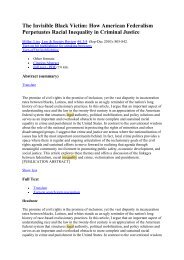Ski – resort and regional development: profile of visitors ... - E-Journal
Ski – resort and regional development: profile of visitors ... - E-Journal
Ski – resort and regional development: profile of visitors ... - E-Journal
Create successful ePaper yourself
Turn your PDF publications into a flip-book with our unique Google optimized e-Paper software.
112<br />
Garyfallos Arabatzis, Serafeim Polyzos <strong>and</strong> Stavros Tsiantikoudis<br />
According to Hovinen (1982) <strong>and</strong> to Mathieson <strong>and</strong> Wall (1982) tourism carrying capacity<br />
is the maximum number <strong>of</strong> people who can use a site without an unacceptable alteration in<br />
the physical environment <strong>and</strong> without an unacceptable decline in the quality <strong>of</strong> experience<br />
gained by <strong>visitors</strong>. Shelby (1987) proposed a more general definition for carrying capacity:<br />
the level <strong>of</strong> use <strong>of</strong> an area beyond which the consequences from this use exceed certain levels<br />
that have been determined by evaluative models.<br />
The most well known interpretation is that by Pearce (1989): "Tourism carrying capacity is<br />
commonly considered as the threshold <strong>of</strong> tourist activity beyond which facilities are saturated<br />
(physical carrying capacity), the environment is degraded (environmental carrying capacity)<br />
or visitor enjoyment is diminished (perceptual or psychological carrying capacity" (Pearce,<br />
1989, p. 169).<br />
Two schools <strong>of</strong> thought have been developed explaining carrying capacity <strong>of</strong> a tourist area<br />
(O’ Reilly, 1986). In one, carrying capacity is considered to be the capacity <strong>of</strong> the destination<br />
area to absorb tourism before negative impacts are felt by the host population. Capacity is<br />
dictated by how many tourists are wanted rather than by how many can be attracted.<br />
The second school <strong>of</strong> thought contends that tourism carrying capacity is the level beyond<br />
which tourist flows will decline because certain capacities, as perceived by tourists themselves,<br />
have been exceeded <strong>and</strong> therefore the destination area ceases to satisfy <strong>and</strong> attract them. The<br />
basic elements <strong>of</strong> carrying capacity are: (a) the quality <strong>of</strong> experience that the <strong>visitors</strong> are<br />
exposed to before they look for alternative destinations <strong>and</strong> (b) the level <strong>of</strong> the host community’s<br />
tolerance at the presence <strong>of</strong> tourists.<br />
The endogenous factors <strong>of</strong> an area that influence carrying capacity are the following:<br />
• Natural environmental characteristics <strong>and</strong> activities (topography, soil, vegetation, climatic<br />
conditions).<br />
• Economic infrastructure <strong>and</strong> economic <strong>development</strong> (level <strong>of</strong> economic <strong>development</strong><br />
spatial characteristics <strong>of</strong> growth, investment planning, import-export characteristics <strong>and</strong><br />
diversity <strong>of</strong> economy).<br />
• Social infrastructure <strong>and</strong> organisation (demographic <strong>pr<strong>of</strong>ile</strong> <strong>of</strong> local population, local<br />
tradition, social organisation, perceptions, behaviours, values towards the tourists.<br />
• Political organisations (national, <strong>regional</strong> <strong>and</strong> local tourist organisations’ role, motives<br />
<strong>and</strong> limits that influence the tourist impacts).<br />
• Level <strong>of</strong> tourism <strong>development</strong> (rate <strong>of</strong> growth, types <strong>and</strong> quality <strong>of</strong> lodgings, entertainment<br />
<strong>and</strong> restaurant facilities, travel agents).<br />
Respectively the exogenous factors are: the visitor’s characteristics (age, sex, income, motives,<br />
behaviours <strong>and</strong> expectations), level <strong>of</strong> use <strong>of</strong> facilities, density <strong>of</strong> <strong>visitors</strong>, duration <strong>visitors</strong>’<br />
staying in the area, activities <strong>of</strong> <strong>visitors</strong> in the area, level <strong>of</strong> tourist satisfaction.<br />
Tourism Today - Fall 2007 - Full Paper














